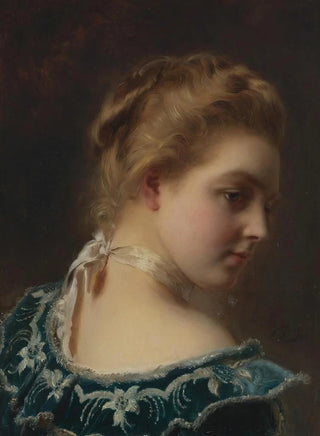Art print | Young beauty in green dress - Gustave Jean Jacquet


View from behind

Frame (optional)
In the fascinating universe of art, some artworks manage to transcend time and capture the essence of an era. "Young Beauty in a Green Dress - Gustave Jean Jacquet" is one of those creations that, through its delicacy and elegance, invites prolonged contemplation. This piece, which evokes the splendor of femininity, transports us to a world where beauty is both a subject and a feeling. Through Jacquet's gaze, the viewer is immersed in an atmosphere imbued with grace and refinement, where every detail contributes to creating a striking visual harmony. The green dress, symbolizing freshness and vitality, becomes the focal point of a composition that celebrates youth and timeless beauty.
Style and uniqueness of the work
Gustave Jean Jacquet's style is distinguished by remarkable technical mastery and keen artistic sensitivity. In "Young Beauty in a Green Dress," the artist uses a palette of rich, nuanced colors, highlighting the vibrant green of the dress that envelops the female figure. This chromatic choice, combined with subtle lighting, gives the artwork an atmosphere that is both lively and dreamlike. The delicate features of the young woman's face, as well as her pensive expression, reflect deep introspection, inviting the viewer to ponder her thoughts and emotions. Jacquet thus manages to establish a dialogue between the artwork and its observer, creating an emotional connection that transcends mere observation. The composition, carefully balanced, emphasizes the graceful silhouette of the model, while incorporating decorative elements that evoke a bourgeois interior, typical of the late 19th century.
The artist and his influence
Gustave Jean Jacquet, born in 1846, was a French painter whose work is rooted in the academic tradition while incorporating elements of the Impressionist movement. His career, marked by a constant pursuit of beauty and harmony, allowed him to establish himself among the notable artists of his time. Jacquet often explored the representation of women, placing them at the center of his compositions and celebrating

Matte finish

View from behind

Frame (optional)
In the fascinating universe of art, some artworks manage to transcend time and capture the essence of an era. "Young Beauty in a Green Dress - Gustave Jean Jacquet" is one of those creations that, through its delicacy and elegance, invites prolonged contemplation. This piece, which evokes the splendor of femininity, transports us to a world where beauty is both a subject and a feeling. Through Jacquet's gaze, the viewer is immersed in an atmosphere imbued with grace and refinement, where every detail contributes to creating a striking visual harmony. The green dress, symbolizing freshness and vitality, becomes the focal point of a composition that celebrates youth and timeless beauty.
Style and uniqueness of the work
Gustave Jean Jacquet's style is distinguished by remarkable technical mastery and keen artistic sensitivity. In "Young Beauty in a Green Dress," the artist uses a palette of rich, nuanced colors, highlighting the vibrant green of the dress that envelops the female figure. This chromatic choice, combined with subtle lighting, gives the artwork an atmosphere that is both lively and dreamlike. The delicate features of the young woman's face, as well as her pensive expression, reflect deep introspection, inviting the viewer to ponder her thoughts and emotions. Jacquet thus manages to establish a dialogue between the artwork and its observer, creating an emotional connection that transcends mere observation. The composition, carefully balanced, emphasizes the graceful silhouette of the model, while incorporating decorative elements that evoke a bourgeois interior, typical of the late 19th century.
The artist and his influence
Gustave Jean Jacquet, born in 1846, was a French painter whose work is rooted in the academic tradition while incorporating elements of the Impressionist movement. His career, marked by a constant pursuit of beauty and harmony, allowed him to establish himself among the notable artists of his time. Jacquet often explored the representation of women, placing them at the center of his compositions and celebrating






